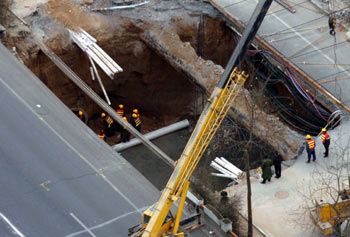|
Beijing is coming apart at the seams
(The Times)
Updated: 2006-01-06 08:48 The citizens of China’s capital are fiercely proud
that it will host the Olympics in 2008, but massive rebuilding, smog, appalling
traffic and rising living costs are fraying their nerves.

Construction workers are seen repairing a
cave-in on the east Third Ring Road in Beijing January 4, 2006. The
cave-in don't inflict serious traffic congestion because of the
municipal goverment's timely response, according to media reports. A
sewage pipeline leak in the early rush hours of yesterday morning
caused an eastern section of the Third Ring Road to cave in, creating a
hole of 20 metres long, 10 metres wide and 10 metres deep. No casualties
were reported. [Xinhua] |
The latest
incident to beset Beijingers was a huge hole — 20m (65ft) long, 10m wide and 10m
deep — in a busy section of one of the ring roads encircling the city of 14
million.
“Filthy water leaked out of the pipe and poured into a section of the subway
line that is under construction,” was how the Beijing Evening News reported the
hole, which opened just a week after a burst water pipe caused the road to sink
in the southern district of Xuanwu.
A report by a Chinese consulting firm added insult to injury when a survey
showed that Beijing had plunged to fifteenth place from fourth in an annual
ranking of China’s most liveable cities. Fewer people want to live in Beijing
because of its bad traffic, high housing prices and heavy pollution, the China
Daily reported.
The northeastern port city of Dalian topped the 2005 list, followed by the
southeastern port of Xiamen. Shanghai, the traditional rival, was ranked
seventh.
The Beijing city planners are building 11 new cities on the capital’s
outskirts to deal with the population overspill.
The cities currently house 2.5 million but ultimately they will accommodate
5.7 million people, Chen Gang, Beijing’s chief planner, said.
“The population is far too dense in Beijing. In some areas the number is
20,000 people per square kilometre. We project the population could top 5.7
million in the future. But this is the limit.”
|